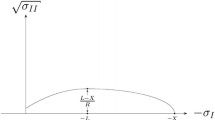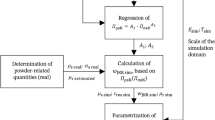Abstract
This paper focuses on studying and adapting modeling techniques using the finite element method to simulate the rigid die compaction of metal powders. First, it presents the implementation of the cap constitutive model into ABAQUS FE software using the closest point projection algorithm. Then, an inverse modeling procedure was proposed to alleviate the problems raised by the interpretation of the experimental tests and to more accurately determine the material parameters. The objective function is formed, based on the discrepancy in density data between the numerical model prediction and the experiment. Minimization of the objective function with respect to the material parameters was performed using an in-house optimization software shell built on a modified Levenberg–Marquardt method. Thus, an integrated simulation module consisting of an inverse optimization method and a finite element method was developed for modeling the powder compaction process as a whole. The simulation and identification module developed was applied to simulate the compaction of some industrial parts. The results reveal that the maximum absolute error between densities is 2.3%. It corresponds to the precision of the experimental method.
Similar content being viewed by others
References
German RM (1994) Powder metallurgy science. Metal Powder Industries Federation, Princeton, NJ
Gurson AL (1977) Continuum theory of ductile rupture by void nucleation and growth. Part I. Yield criteria and flow rules for porous ductile media. Transactions of the ASME. J Eng Mat Technol 99:2–15
Shima S, Oyane M (1976) Plasticity theory for porous materials. Int J Mech Sci 18:285–291
Gurson AL, McCabe J (1992) Experimental determination of yield functions for compaction of blended metal powder. Adv Powder Metall Part Mater 2:133–147
Abou-Chedid G, Brown S (1992) On the mechanical behavior of metal powder compaction. Adv Powder Metall Part Mater 2:1–10
Drucker D, Prager W (1952) Soil mechanics and plastic analysis on limit design. Quart J Applied Math 10:157–175
Schofield AN, Wroth CP (1968) Critical state solid mechanics. McGraw Hill, New York
DiMaggio, FL, Sandler, IS (1971) Material model for granular soils. J Eng Mech Div 97:935–950
Sandler IS, Rubin D (1979) An algorithm and a modular subroutine for the Cap model. Int J Numer Anal Methods Geomech 3:173–186
Falgon D, Vidal-Salle E, Boyer JC, Peczalski R, Andrieu J (2005) Identification procedure of a hardening law for powder compaction. Powder Technol 157:183–190
Michrafy A, Ringenbacher D, Tchoreloff P (2002) Modeling the compaction behavior of powders: application to pharmaceutical powders. Powder Technol 127:257–266
Cunningham JC, Sinka IC, Zavaliangos A (2004) Analysis of tablet compaction. I. Characterization of mechanical behavior of powder and powder/tooling friction. J Pharm Sci 93:2022–2039
Wu CY, Ruddy OM, Bentham AC, Hancock BC, Best SM, Elliott JA (2005) Modeling the mechanical behavior of pharmaceutical powders during compaction. Powder Technol 152:107–117
Wu CY, Hancock BC, Mills A, Bentham AC, Best SM, Elliott JA (2008) Numerical and experimental investigation of capping mechanisms during pharmaceutical tablet compaction. Powder Technol 181:121–129
Frenning G (2007) Analysis of pharmaceutical powder compaction using multiplicative hyperelasto-plastic theory. Powder Technol 172:102–112
Gurson AL, Posteraro RA (1992) Yield functions for metal powders for use in the numerical simulation of powder compaction. TMS Conference, San Diego, CA
Chtourou H, Gakwaya A, Guillot M (2002) Modeling of the metal powder compaction process using the cap model. Part II: numerical implementation and practical applications. Int J Solids Struct 39:1077–1096
Erhart T, Wall WA, Ramm E (2005) A robust computational approach for dry powders under quasi-static and transient impact loadings. Comput Meth Appl Mech Eng 194:4115–4134
Rossi R, Alves MK, Al-Qureshi HA (2007) A model for the simulation of powder compaction processes. J Mater Process Technol 182:286–296
Khoei AR, Azami AR, Azizi S (2007) Computational modeling of 3D powder compaction processes. J Mater Process Technol 185:166–172
Lee SC, Kim KT (2007) A study on the Cap model for metal and ceramic powder under cold compaction. Mater Sci Eng, A 445–446:163–169
Szantoa M, Bierb W, Fragec N, Hartmannb S, Yosibash Z (2008) Experimental based finite element simulation of cold isostatic pressing of metal powders. Int J Mech Sci 50:405–421
Pizette P, Martin CL, Delette G, Sornay P, Sans F (2010) Compaction of aggregated ceramic powders: from contact laws to fracture and yield surfaces. Powder Technol 198:240–250
Andersson DC, Larsson PL, Cadario A, Lindskog P (2010) On the influence from punch geometry on the stress distribution at powder compaction. Powder Tech 202(1–3):78–88
Peric D (1992) On consistent stress rates in solid mechanics: computational implications. Int J Numer Methods Eng 33:799–817
Peric D, Owen DRJ, Honnor ME (1992) A model for finite strain elasto-plasticity based on logarithmic strains: computational issues. Comput Meth Appl Mech Eng 94:35–61
Chtourou H, Gakwaya A, Guillot M, Hrairi M (1995) Implementing a cap material model for the simulation of metal powder compaction. Net Shape Processing of Powder Materials, AMD-vol. 216, ASME, San Fransisco, CA, pp. 19–27
Alm O (1983) Mechanical testing of powders and powder compacts. Scand J Metall 12:302–311
Weber GG, Brown SB (1989) Simulation of the compaction of powder components. Adv Powder Metall Part Mater 1:105–118
Simo JC, Ortiz M (1985) A unified approach to finite deformation elastoplasticity based on the use of hyperelastic constitutive equations. Comput Meth Appl Mech Eng 49:222–245
Simo JC, Taylor RL (1986) A return mapping algorithm for plane stress elastoplasticity. Int J Numer Methods Eng 22:649–670
Simo JC, Ju JW, Pister KS, Taylor RL (1988) Assessment of Cap model: consistent return algorithms and rate-dependent extension. J Eng Mech 114:191–218
Hofstetter G, Simo JC, Taylor RL (1993) A modified Cap model: closest point solution algorithms. Comput Struct 46(2):203–214
Chtourou H, Gakwaya A, Guillot M (2002) Modeling of the metal powder compaction process using the cap model. Part I: experimental material characterization and validation. Int J Solids Struct 39:1059–1075
Pavier E, Doremus P (1996) Mechanical behaviour of a lubricated iron powder. In: Cadle TM, Narasimhan KS (eds) Advances in powder metallurgy and particulate materials—1996. Metal Powder Industries Federation, USA, pp 6–40
Mosbah P (1995) Modeling and experimental study of metal powders behaviour during comaction in closed die. Ph.D. thesis, University Joseph Fourier-Grenoble I, Grenoble, France
Gelin JC, Ghouati O (1995) An inverse method for material parameters estimation in the inelastic range. Comput Mech 16(3):143–150
Mahnken R, Stein E (1996) A unified approach for parameter identification of inelastic material models in the frame of the finite element method. Comput Meth Appl Mech Eng 136:225–258
Levenberg K (1944) A method for the solution of certain nonlinear problems in least squares. Quart Appl Math 2:164–168
Marquardt DW (1963) An algorithm for least squares estimation of nonlinear parameters. SIAM J Appl Math 11:431–441
Hrairi M (1999) Modélisation Numérique et Identification Directe et Inverse du Comportement des Poudres Métalliques lors du Procédé du Compactage. Ph.D. Thesis, Laval University, Québec
Abaqus (1995) Theory Manual Version 5.5. Hibbit, Karlsson and Sorenson, Inc., Rhode Island
Samuelson P, Bolin B (1983) Experimental studies of frictional behavior of hard metal powders sliding on cemented carbide walls. Scand J Metall 12:315–322
Khoei AR, Biabanaki SOR, Vafa AR, Taheri-Mousavi SM (2009) A new computational algorithm for 3D contact modeling of large plastic deformation in powder forming processes. Comput Mater Sci 46:203–220
Guillot M, Chtourou H (1996) Generalization of the Vickers hardness local density measurement technique to different powder materials. Proceedings of the World Congress on Powder Metallurgy and Particulate Materials, vol. 1, part 4, pp.31–40
SDRC Corporation (1994) Ideas Master Series Student Guide
Hibbitt K (1997) ABAQUS theory manual, Version 5.7, Sorensen, Inc., Boston, USA
Hibbitt K (1997) ABAQUS-post user guide, Version 5.7, Sorensen, Inc., Boston, USA
Chtourou H, Gakwaya A, Guillot M, Hrairi M (1996) Finite element simulation of the rigid die compaction of metal powder components. Proceedings of the Canadian Societyof Mechanical Engineers Forum. McMaster University, Hamilton, Canada
ASTM E92-82 (1987) Standard test method for Vickers hardness of metallic materials
MPIF Standard 43 (1991). Method for determination of hardness of powder metallurgy products, Princeton, NJ
Author information
Authors and Affiliations
Corresponding author
Rights and permissions
About this article
Cite this article
Hrairi, M., Chtourou, H., Gakwaya, A. et al. Modeling the powder compaction process using the finite element method and inverse optimization. Int J Adv Manuf Technol 56, 631–647 (2011). https://doi.org/10.1007/s00170-011-3211-z
Received:
Accepted:
Published:
Issue Date:
DOI: https://doi.org/10.1007/s00170-011-3211-z




